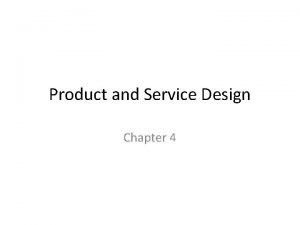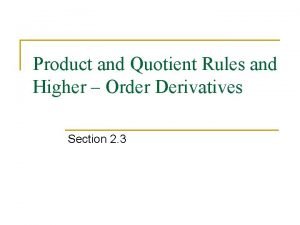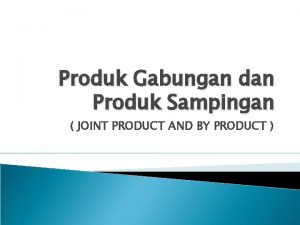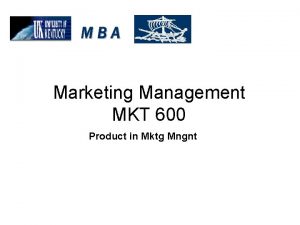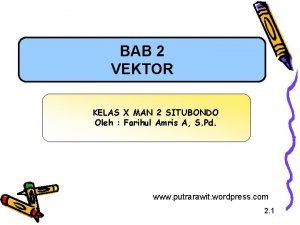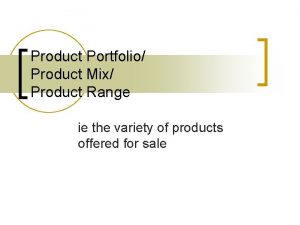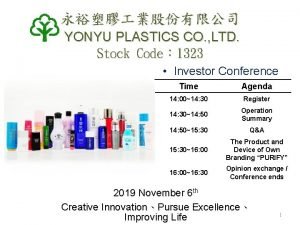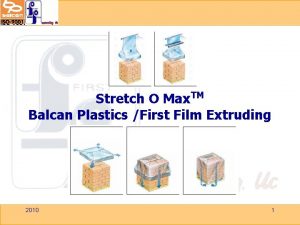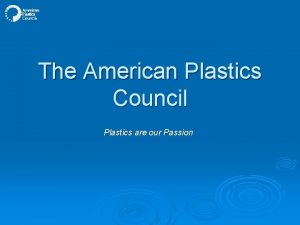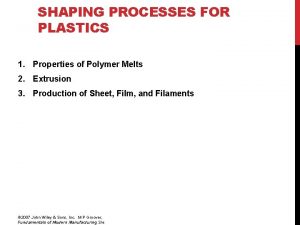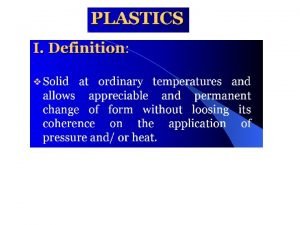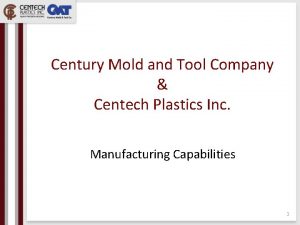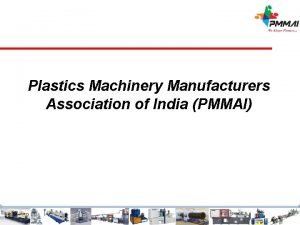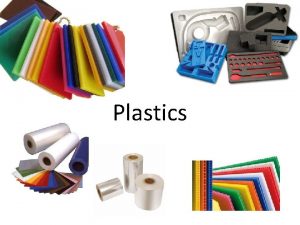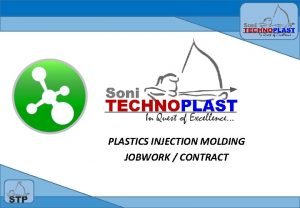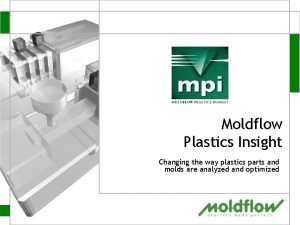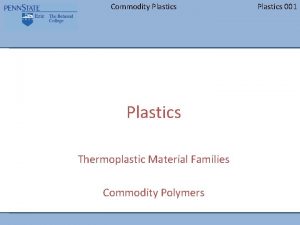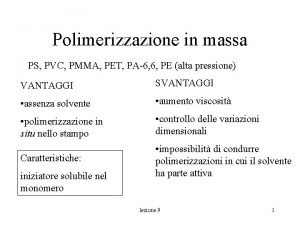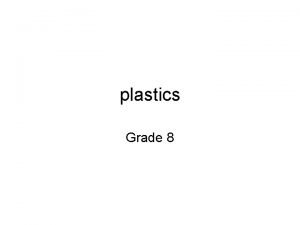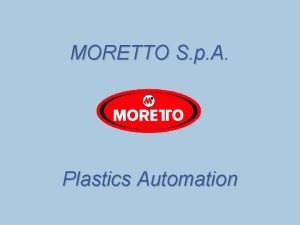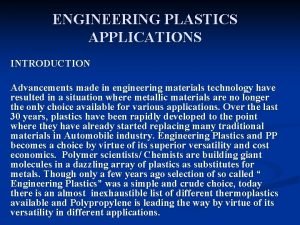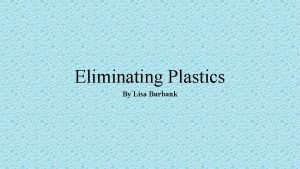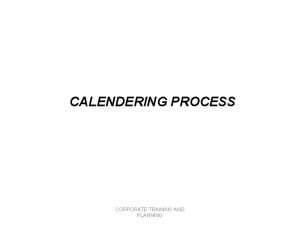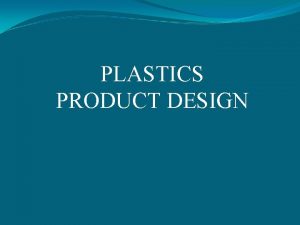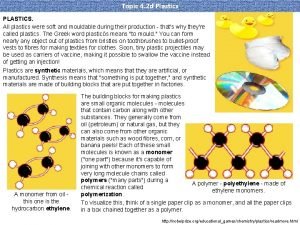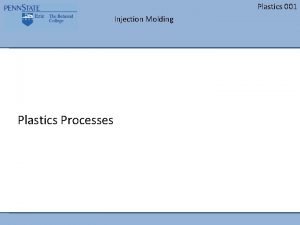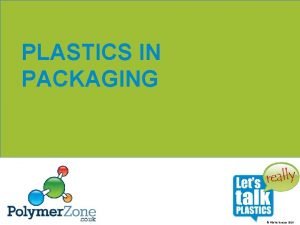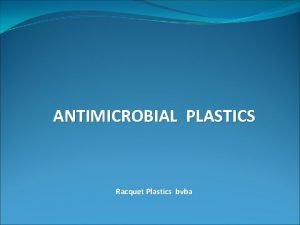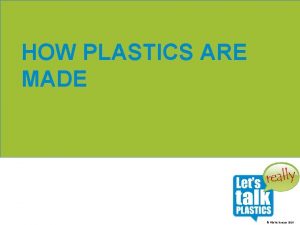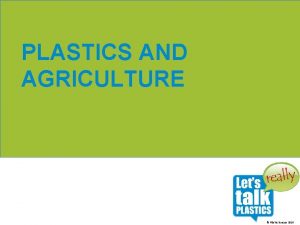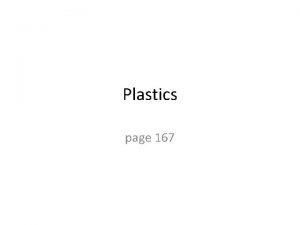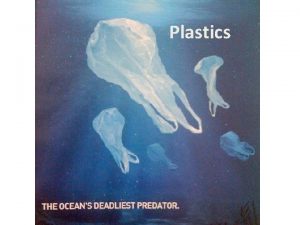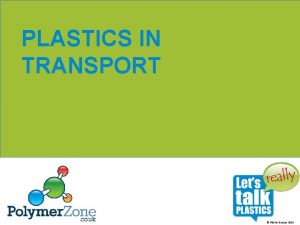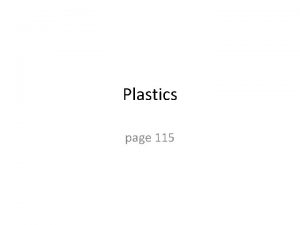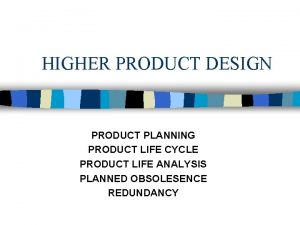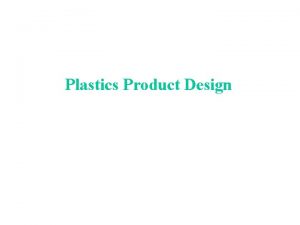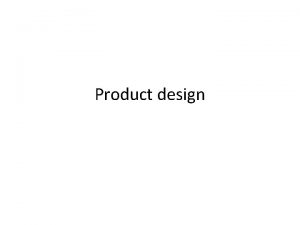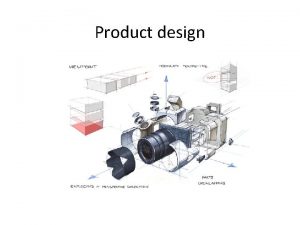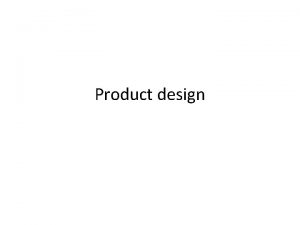PLASTICS Higher Product design PLASTICS Section 1 PLASTICS



































- Slides: 35

PLASTICS Higher Product design

PLASTICS Section 1

PLASTICS THE BASICS Natural plastics: fossilised tree resin and latex Form of rubber Synthetic plastics: Chemically manufactured from carbon based materials such as crude oil, coal and gas Polymerisation: how plastics are manufactured Occurs when monomers join together to form long chains of molecules called polymers. monomers polymerisation Polymer

INFORMATION ABOUT PLASTIC Basic chemicals used in creating plastics are from coal and crude oil. Obtained by using heat and chemical catalysts Four main stage in converting these raw materials into plastic products 1. extraction of basic chemical from crude oil 2. refine and process the basic chemical into monomers 3. convert the refined chemicals into polymers in formation of plastic granules 4. process the plastic granules into products.

WHAT CAN CHANGE THE PLASTIC? Additives modify properties of plastic dependant on what the product will be. Fillers – eg. Powered chalk to bulk out the plastic changing its appearance and reducing costs Pigments – to give plastic its colour Additives – eg. Carbon fibres to improve strength Stabilisers – to guard against decomposition or damage cause by light Flame retardants – reduces flammability Lubricants – help the flow of plastic during processes Blowing agents – releases gas to make foamed or expanded plastics.

PLASTIC PROPERTIES Ideal for mass production of quality products Light in weight Resistance to corrosion Low thermal conductivity Translucent, transparent and opaque Electrically resistant Easily formed Recyclable

FORMS PLASTIC COMES IN Profiled sheets, rods, tubes and bars Moulding compounds Thin layers of films and sheets Foam Casting compounds such as ingots Paint, varnish and lacquer used for finishing Filaments and fibres Composites that contain reinforcing material

Heated THERMOSETTING PLASTICS Formed by chemical reactions that leave them in a relatively fixed state. They cannot be softened or reformed when reheated. Can withstand high temperature, excess heat will cause material to decompose. Used when products needs resistance to extremes in temperature, electrical current, chemicals and wear. Permanently hard Softens Shaped

THERMOSETTING PLASTICS Some examples of thermosetting plastics are: Epoxy Resin ER(Araldite) – good adhesive, low shrinkage, strong when reinforced. Used in bonding, laminating, surface coating, printed circuit boards Polyester Resin PR(Orel Beetle) – stiff, hard, brittle, resilient as laminated GPR, formed without heat or pressure. Used in panels for car bodies and boat hulls, casting and embedding Melamine formaldehyde MF(Formica Melaware) – waterproof, tasteless, odourless, mark and scratch resistant. Used in worktops, tableware, buttons, electrical insulation. Urea Formaldehyde UF(Aerolyte Cascamite) – good adhesive, stiff, hard, brittle, good electrical insulator. Used in electrical fittings, paper and textile coating, wood adhesive. Phenol Formaldehyde PF (phenol methanal) – Hard, brittle plastic with dark colour, glossy finish. Resists heat. Used in parts for domestic appliances, bottles tops, kettle/iron/saucepan handles.

Heated THERMOPLASTICS Softens Hardens Softens when heated, hardens when cooled down Can be repeated indefinitely When soft they are easily formed under pressure. PLASTIC MEMORY – this is the property of thermoplastic returning to its original shape when softened after being shaped. Shaped

THERMOPLASTIC Polyethene HDPE – High density, tough, resists chemicals, feels waxy. Used for rigid objects: buckets, bowls, sterilised containers. Polyethene LDPE – Low density, soft and pliable, electrical insulator. Used for flexible objects: bags, bottles, cable, sheathing, toys. Polypropene PP – rigid, light, good chemical resistance, resistance to fatigue, bending. Used for crates, seats, string, rope, medical equipment, hinges, kitchenware, film. Polystyrene PS – light, buoyant, stiff, water/weather resistant. Used for packaging, containers, insulation and toys. Polyvinyl chloride UPVC – rigid, abrasive resistance, water/weather resistant. Used for piped, gutters, bottles, roofing, window frames. Poly-methacrylate PMMA (Acrylic/Perspex) – Stiff, hard, clear, durable, scratches easily, easily machined and polished. Used for signs, lighting, reflectors/lenses cases, jewellery. Nylon – Hard material, good resistance to wear and tear. Solid nylon has low friction qualities and high melting point. Used in curtain rail fittings, combs, clothes and gear wheels.

ELASTOMERS Particular branch of thermoplastics Has elastic properties Similar to rubber in how it reacts to pressure and their texture Withstands large amounts of deformation Can be stretched several times to their length. Uses: Waterproof seals Diaphragms for mechanical purposes Flexible handles Sportswear Foam padding

COMPOSITE MATERIALS Consists of two or more substances Combines to produce properties that no single substance can achieve. One component forms the matrix (base) while the other provides reinforcement Properties are controlled by size and distribution of reinforcing substance.

EXAMPLE OF COMPOSITE MATERIAL Using carbon fibres embedded in Resin � Carbon-fibre reinforced plastic CFRP Properties are: Low in density Light in wieght High tensile strength Better corrosion resistance and fatigue performance than most metal alloys Used in aerospace industry and car frameworks.

COMPOSITE MATERIALS REINFORCED 4 ways to reinforce a composite material: 1. Dispersion composites: Fine particles (1 -15%) that harden the material preventing the spread of internal defects. Characterised by increasing strength that is unaltered by increases in temperature. Example: SAP (Sintered Aluminium Powder) composite of alumina in aluminium. 2. Particulate composites: larger particles (>20%). Brittle nature of ceramics resulted in large numbers in this class. Example: grinding wheels and ceramic-tipped cutting tools 3. Fibrous composites: Wide variation of materials. Parents material is used to bind fibres and protect the surface from damage. Example: Fibre reinforced plastics FPR include glass fibre in a polyester resin mix that are used in boat hulls and car bodies. 4. Laminated or Later composites: Alternate layers of material bonded together and can consist of thin coatings, thicker protective surfaces, claddings, bi-metallic layers. Laminates or sandwiches. Examples: Plywood. Safety glasses have a plastic film sandwiched

PLASTIC PROCESSING Plastics part 2

INJECTION MOULDING Allows large quantities of plastic components to be made quickly Most important industrial process in mass production of plastic goods. Costs of machining original moulds are very high therefore necessary to sell large numbers of products to recover costs. Most thermoplastics are used, in particular polypropylene, ABS, HDPE There a few features which help identify this process: Sprue marks Draw angles Mould split lines Ejection pin marks Webs used for strength Variation of finishing techniques from high quality shine to texture

INJECTION MOULDING 1. Granules of plastic powder are poured or fed into a hopper which stores it until it is needed. 2. A heater heats up the tube and when it reaches a high temperature a screw thread starts turning. 3. A motor turns a thread which pushes the granules along the heater section which melts then into a liquid. 4. The liquid is forced into a mould where it cools into the shape (in this case a sphere). 5. The mould then opens and the sphere is removed.

INJECTION MOULDING (USES) High volume, automated industrial manufacturing process. Golf tees Spoons Wash basins Buckets Product casings

EXTRUSION Used for products with long uniform cross sections. Variety of metals and thermo-plastics are suited to the extrusion process. Plastic is easier as it requires less force Polythene, PVC, polypropylene Lead, copper, brass, bronze, aluminium, steel Features that help identify this process; smooth-walled long sections Line texturisation

EXTRUSION A machine is used to extrude materials which is very similar to the injection moulding. A motor turns a thread which feeds granules of plastic through a heater. The granules melt into a liquid which is forced through a die, forming a long 'tube like' shape. The extrusion is then cooled and forms a solid shape. The shape of the die determines the shape of the tube.

EXTRUSION (USES) Curtain rails Drainpipes Electric cable sheathing Fluorescent light covers Hose pipes

BLOW MOULDING Several variations to the process, producing various sizes Finish is not as high a standard as injection moulding Good mould allows: Uniform thickness Complex shape Good quality of production Fast process Little waste Features that allow for identification: Mould separation lines Flash lines Any shape of bottle or container Transparent, opaque or coloured

BLOW MOULDING The process is similar to injection moulding and extrusion. 1. The plastic is fed in granular form into a 'hopper' that stores it. 2. A large thread is turned by a motor which feeds the granules through a heated section. 3. In this heated section the granules melt and become a liquid and the liquid is fed into a mould. 4. Air is forced into the mould which forces the plastic to the sides, giving the shape of the bottle. 5. The mould is then cooled and is removed.

BLOW MOULDING (USES) Variety of mass produced bottles and liquid containers, using variety of polymers and laminates.

COMPRESSION MOULDING Used for shaping thermosetting plastics These are strong and brittle but have poorer impact resistance than thermoplastics Features that identify compression moulding: Walls of uniform thickness 3 -6 mm Draft 1˚ minimum Flashes on edges Quality finish on female mould Plastic used can resist temperature increases.

MOULD THROUGH COMPRESSION The stages are as follows: 1. The mould is heated. 2. A 'slug' or piece of the plastic is placed into the mould and warms up. 3. The hydraulic press begins to move down when the plastic has reached the correct temperature. . 4. As the upper and lower mould meet, the plastic is compressed into the shape of the mould. 5. The upper mould moves upwards and the plastic piece (in this case a dish) is removed.

COMPRESSION MOULDING (USES) Automotive distributor caps (cars) Camera cases Electrical wall sockets Handles Door knobs Light switches

VACUUM FORMING Widely used in industrial processes to mould plastic. No need for expensive moulds or dies Moulds generally used from wood/ steel/ aluminum Process is over in a few minutes Thermoplastics are suited for this process for example HIPs, Polythene, PVC, HDPE, ABS Features that identify this process: � � � Thin sheets normally used Patterns and textures are transformed from the mould to the product surface Venting holes cause ‘pips’ on surface Tapers are pronounced Thinning on side surfaces

Vacuum forming

VACUUM FORMING (USES) Packaging items that have complex shapes Trays Dishes Margarine tubs Toys Light panels

ROTATIONAL MOULDING Produces “closed and seam free” components made from plastic polymers Products produced are hollow, stress free and come in a wide range of shapes and sizes. Moulds made from steel copper coated for better surface detail Aluminium for better heat transfer Electroformed nickel for best surface detail. Moulds rotates several axes with speed dependent on production requirements. Large moulds have air vents to avoid distorting Suited to small production runs used for prototypes Materials used is PVC, polypropylene, LDPE, Nylon

ROTATIONAL MOULDING (PROCESS) Measured quantity of plastic power is added to mould Mould is closed and rotated slowly around 2/3 axes. Allows distribution over hot surface Plastic melts on contact and builds up even coating on inside surface of mould Mould surface is cooled, plastic retains its shape Mould opens and product is removed.

ROTATIONAL MOULDING (USES) Plastic toys Play equipment Road markers Buoys Large tanks (10, 000 litres)

OTHER PROCESSES Calendering: Thermoplastics are squeezed between hot rollers forming thin sheets or film Casting: useful for thermosetting plastics. Molten plastic poured into mould Bending: thermoplastics heated along a line using strip heater, folded to desired angle. Bending jig sometimes used to hold in place. Fabrication: joining together using a variation of fixings and adhesives Coating: powered thermoplastic melts on surface of heated product. (dip coating) Forming: Layers o glass fibre matting and polyester resin formed over a mould. Resin cures it hardens giving rigidity to fibre/resin matrix. Thermoplastic formed by heating whole sheet till soft then pressed between two formers.
 Differences between products and services
Differences between products and services Product and quotient rules and higher order derivatives
Product and quotient rules and higher order derivatives Higher design and manufacture
Higher design and manufacture New product development and product life cycle strategies
New product development and product life cycle strategies Perbedaan by product dan joint product
Perbedaan by product dan joint product Relationship between total average and marginal product
Relationship between total average and marginal product Product line vs product width
Product line vs product width Mkt 600
Mkt 600 Cross product outer product
Cross product outer product Target market feasibility analysis
Target market feasibility analysis Overview definition
Overview definition Lima buah vektor digambarkan sebagai berikut
Lima buah vektor digambarkan sebagai berikut Core product augmented product
Core product augmented product Product portfolio mix
Product portfolio mix Rumus perkalian silang
Rumus perkalian silang Distinguish between gdp and gnp
Distinguish between gdp and gnp Yonyu
Yonyu Balcan plastics
Balcan plastics American plastics council
American plastics council Characteristics of polymers
Characteristics of polymers Plastics can be shaped into
Plastics can be shaped into Torsion snap joints
Torsion snap joints Centech plastics inc
Centech plastics inc Plastics machinery manufacturers association of india
Plastics machinery manufacturers association of india Properties of plastics
Properties of plastics Stp plastics
Stp plastics Moldflow plastic insight
Moldflow plastic insight Commodity plastics
Commodity plastics Why do different polymers have different properties
Why do different polymers have different properties Distribuzione formosa plastics
Distribuzione formosa plastics Advantages of plastic
Advantages of plastic Moretto plastics automation
Moretto plastics automation Applications of plastics
Applications of plastics Plastics engineering consulting
Plastics engineering consulting Burbank plastics
Burbank plastics Calendaring plastics
Calendaring plastics
